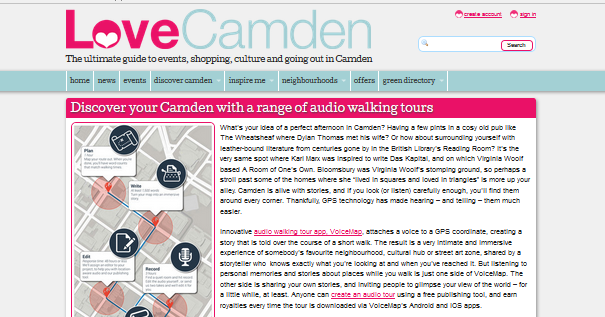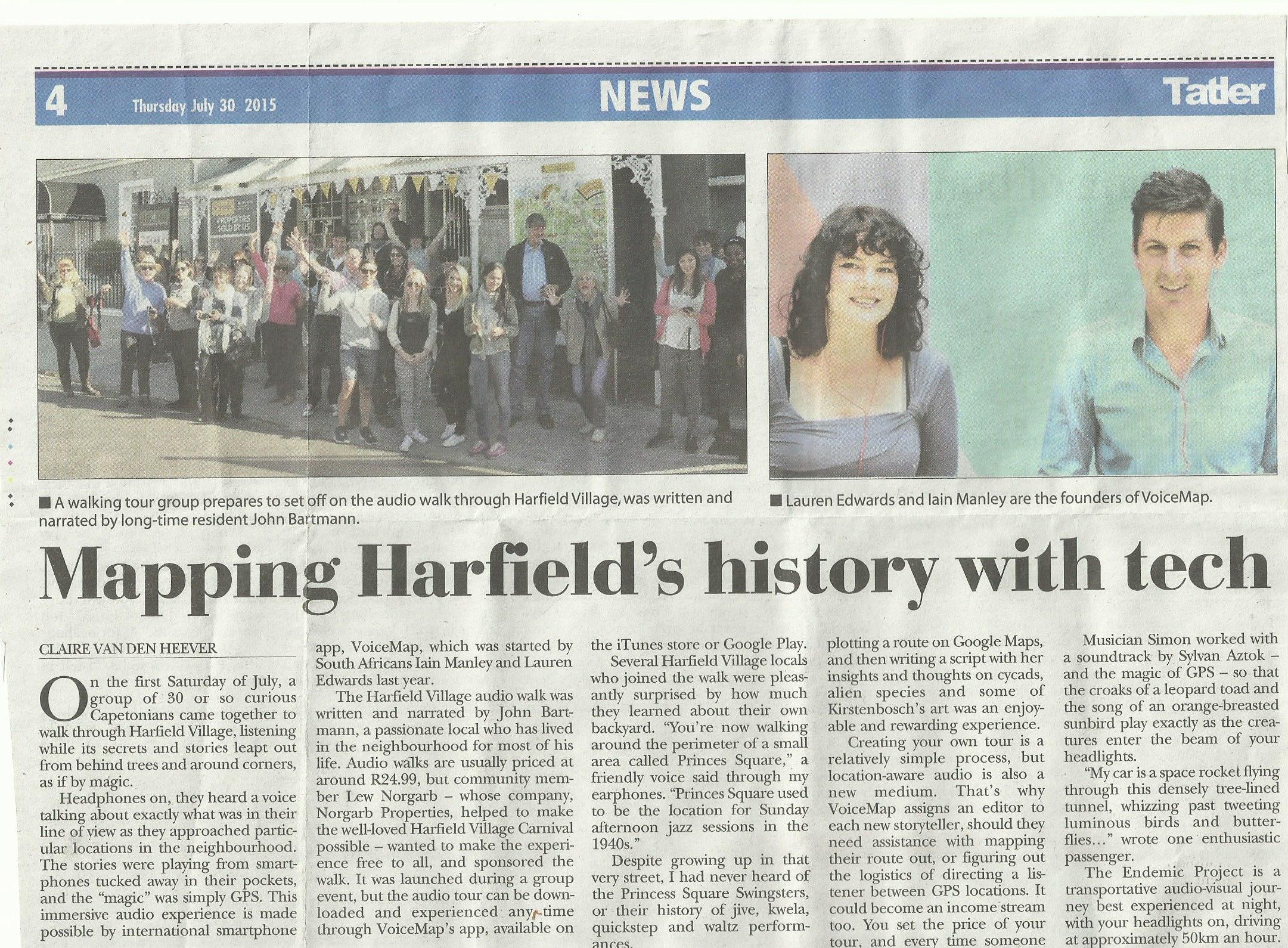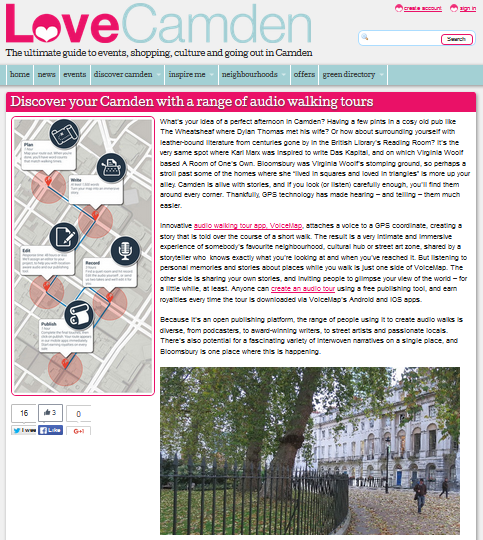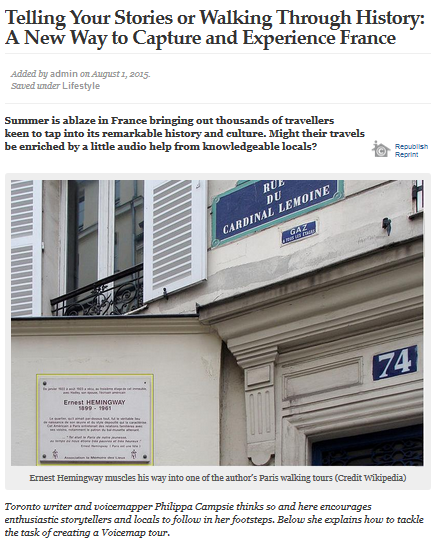Audio tour apps are exciting and new, so getting websites and other publications to run a press release or article about yours shouldn’t be difficult. Press releases are a great way of communicating to specific audiences, and editors are often happy to have the work taken out of writing something themselves.
We’ve done our best to take some of the work out of the process for you, too. Read on to find plenty of examples from press releases – which you can reword to reflect your own personality – along with the four essential questions that a press release promoting your audio tour should answer.
1. What is your tour about and where does it take place?
Example 1:
Brian Cookson’s audio walk weaves its way past the cosy English pub where Dylan Thomas’ stormy marriage began, London University, and the British Museum, and ends in a charming Dickensian alleyway.
Example 2:
Jeanette Clarke, an amateur botanist and lover of the outdoors, used VoiceMap to create an audio tour of her favourite spots in Kirstenbosch Botanical Gardens. She visits the gardens almost every weekend, so plotting a route on Google Maps, and then writing a script with her insights and thoughts on cycads, alien species and some of Kirstenbosch’s art was an enjoyable and rewarding experience.
This would be a good place to link effectively to your tour.
2. What can I expect?
Paint a picture of a scene from the tour or include quotes from the script. Writing from an outsider’s point of view not only allows you to quote yourself, it also can also make promoting your own creation feel less awkward.
Example 1:
MacLean first set foot in the city during the Cold War as “a teenage Canadian ‘doing’ Europe”, he explains in Into the Heart of Berlin, the first of his three audio walks. “Stop here for a moment,” he says at a blank stretch of ground around the back of the Reichstag. “We’re right where the Wall used to stand. Let me tell you about the first time I saw it.”
Example 2:
“Everything I’m going to tell you is completely factual,” says born-and-bred Londoner, Joey Leskin. “But it’s not the stuff you learnt at school. We’re going to talk about religion, drinking, and a dash of prostitution.”
3. Who are you (and why did you create this tour)?
Example 1:
Joey Leskin, a tour guide, travel writer and “friendly guy occasionally found eating Doritos and dip at various locations around London” has used innovative new storytelling platform, VoiceMap, to create his own audio walking tour of London’s alternative history. The result is an immersive and entertaining experience through central London that will spark a sense of curiosity you never knew you had.
Joey has lived in London all his life, and what lies beneath the city’s outermost layers fascinates him. He has a real knack for looking beyond the ordinary, and shares these alternative perspectives with an endearing balance of eloquence and humour.
Example 2:
Kathleen Dixon Donnelly’s research for her Ph.D.in Communications from Dublin City University was on early 20th century writers’ salons. She has given presentations about these writers at lifelong learning programs in the United States as well as the United Kingdom, where she currently lives, and led tours of the areas where they gathered—the west of Ireland, Paris’ Left Bank, and Bloomsbury.
“These were incredibly creative people, and I was fascinated by what went on when they were ‘hanging out’ together, in the early time of their careers,” says Dr Dixon Donnelly. “Walking around Bloomsbury you get a real feel for how they were in and out of each other’s houses, interacting in their daily lives.”
4. How does the audio tour work?
Please feel free to directly copy and paste any of the content in this section.
Example 1:
VoiceMap works by attaching a voice to a GPS coordinate, creating a story that is told over the course of a short walk. The result is an intimate and immersive experience of somebody’s favourite neighbourhood, cultural hub or street art zone. VoiceMap also encourages people to share their own stories. Anyone can create an audio tour using a free publishing tool, and earn royalties every time the tour is downloaded via VoiceMap’s Android and iOS apps.
Example 2:
VoiceMap, a recently-launched mobile application for iPhones and Android devices, is using cutting-edge GPS technology and the age-old art of storytelling to change the way people experience cities. “VoiceMap is a publishing platform for location-aware audio tours – or, with less jargon and more poetry, a way of seeing the world through another person’s eyes,” explains CEO and co-founder, Iain Manley.
After downloading the app and selecting a route, VoiceMap users can put their phone in their pocket and follow a storyteller’s voice through a particular neighbourhood, while anecdotes, commentary and opinions play automatically at specific GPS locations.
Example 3:
On the first Saturday of July, a group of 30 or so curious Capetonians came together to walk through Harfield Village, listening while its secrets and stories leapt out from behind trees and around corners, as if by magic. Headphones on, they heard a voice talking about exactly what was in their line of view as they approached particular locations in the neighbourhood. The stories were playing from smartphones tucked away in their pockets, and the “magic” was simply GPS. This immersive audio experience is made possible by international smartphone app, VoiceMap, which was started by South Africans Iain Manley and Lauren Edwards last year.
Example 4:
VoiceMap uses your smartphone’s GPS device to play audio at specific locations. After downloading the audio walk using the instructions below, just put in your headphones and start walking.
To download the walk in the Android or iPhone apps, follow these steps:
1) Install VoiceMap by going to bit.ly/voicemap (iPhone) or bit.ly/getvoicemap (Android)
2) Sign in or create an account
3) Select [city name] from the list of cities
4) Then select [route name]
5) Tap on the red download button. The audio walk costs [price]. You can pay using your iTunes and Google Wallet accounts. Allow ALL the files to finish downloading before you close the app.
6) When the download is finished, the download button will change from red to green, and instead of seeing the price, you’ll see the word “Start”. You’re ready to go!
The “create your own audio tour” angle
This is by no means essential, but you may like to tell your readers that they, too, can create their own audio tours. If you do, don’t forget to link to the Create Your Own Audio Tour page.
Example 1:
VoiceMap is an open platform for storytellers to create location-aware audio experiences or, put more simply, it’s a tool for creating your own audio tour, with free assistance from their team of editors. The tours are sold for between $0.99 and $9.99, and VoiceMap pays 50% of each tour’s earnings as royalties to the storyteller. The idea is to take a medium that has required costly hardware and software until now, and open it up to new voices.
Example 2:
VoiceMap has two sides to it: a walking tour app that provides both visitors and locals with insightful audio commentary, and a free publishing tool for storytellers to create their own audio tours.
Example 3:
Listening to personal memories and stories about places while you walk is just one side of VoiceMap. The other side is sharing your stories and passions by creating your own audio walk (or drive, or cycle, or run) on VoiceMap’s open publishing platform.
Creating your own tour is a relatively simple process, but location-aware audio is also a new medium. That’s why VoiceMap assigns an editor to each new storyteller, should they need assistance with mapping their route out, or figuring out the logistics of directing a listener between GPS locations. It could become an income stream too. You set the price of your tour, and every time someone downloads it via VoiceMap’s Android and iOS apps, you earn royalties of approximately 50%. To get started, go to www.voicemap.me/create.
Example 4:
VoiceMap is a platform on which anyone with a story to tell can make their voice heard, and the company’s business model allows writers, tour guides or professional audio producers to earn royalties while doing so.
If you’d like someone to give your press release a proofread, or to check the links before you start distributing it for publication, feel free to email me. I’d be happy to help.




